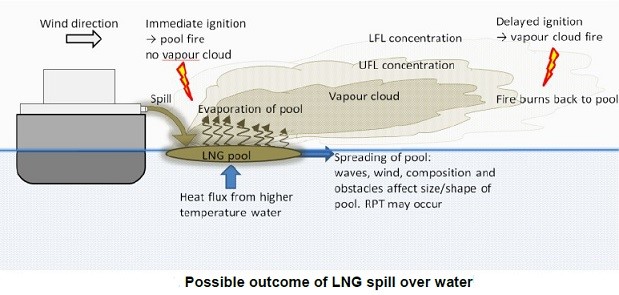Managing Hazards Of A LNG Spill


Liquefied natural gas (LNG) is often regarded as extremely dangerous and toxic with container ships. Natural gas vapors are flammable, and LNG typically contains methane, ethane and propane. LNG presents safety hazards that must be managed. When LNG spills, it vaporizes quickly and leaves behind no residues. As LNG vaporizes, the vapor cloud can ignite if there is a source of ignition, but otherwise LNG dissipates completely.
Industry standards
To handle LNG safely, it is stored in industry standard tanks (double walled, insulated, of proper metals according to the relevant EU (CEN) standards, or to the US standards, e.g. NFPA59) transferred in closed systems with redundant controls. LNG facilities and equipment are designed with special features to ensure containment of LNG and its vapors.
Hazards of a LNG spill
Hazards of a large LNG spill over water includes asphyxiation, cryogenic burns and cryogenic damage to the ship from the LNG, dispersion, fires, and explosions. Thermal hazards occur too from the fire that breaks out during a spill. Cryogenic and fire damage to an LNG ship cause further damage to LNG cargo tanks following an initial cargo tank breach, though the additional impact on public safety would be limited.

Risk management approaches
Risks and hazards from a potential marine LNG spill can be reduced through a combination of approaches, including reducing the potential for a spill, reducing the consequences of a spill, or improving LNG transportation safety equipment, security, or operations to prevent or mitigate a spill. Other approaches include:
- improvements in ship and terminal safety/security systems including improved surveillance, tank and insulation upgrades, tanker standoff protection systems;
- modifications and improvements in LNG tanker escorts, extension of vessel movement control zones, and safety operations near ports and terminals;
- improved surveillance and searches of tugs, ship crews, and vessels;
- redundant or offshore mooring and offloading systems; and
- improved emergency response systems to reduce fire and dispersion hazards and improved emergency response coordination and communication.
Risk prevention and mitigation techniques are especially useful in zones where the potential impact on public safety and property can be high. The hazards of brittle fracture, rapid phase transitions, and explosions in confined ship spaces, as well as cascading events that may result from the extreme fire exposure.
In the case of a leakage or spillage of LNG, the following general procedure should be followed:
- Isolate source of LNG. If loading/discharging, the ESD system should be activated.
- Summon assistance.
- Protect the hull from risk of cold fracture.
- Speed vaporisation to minimise ignition risk.
The exact procedure will depend upon the nature of the incident, inclusive of size of spill, location, ambient conditions and ignition risks.
LNG Loading Master & Certification is a 3-day training course held from 24 – 26 September 2018 (Kuala Lumpur) which prepares the Loading Master for their role in handling LNG. You will be able to understand and perform all aspects of the LNG Ship/Shore Interface and safely perform loading masters duties and responsibilities such as ship/shore safety checklist, understanding volume, handling cryogenic substances and the entire custody transfer process. For more information, please contact us at info@opuskinetic.com.
Interested to read other articles on Maritime? Check out: A Guide To Laytime & Avoiding Demurrage Charges
Opus Kinetic believes that people are why organisations are successful, and giving people the knowledge to perform well at their job is integral for success. We pride ourselves as the premier provider of knowledge, offering acclaimed in-house trainings, and many others professional training courses spanning from various industries. Our training courses are well researched and updated with the latest industry trends. For more information on our professional training programs, visit us at http://www.opuskinetic.com/training.
